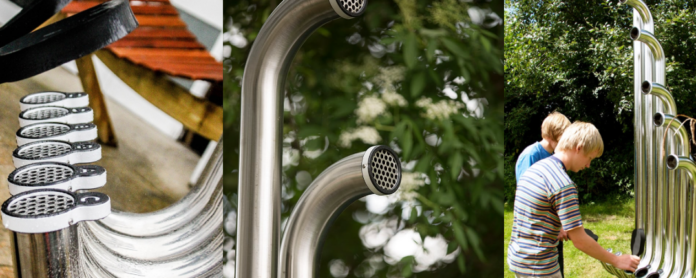The links between music and language development are well known and many studies have concluded that children who have early musical training will develop the areas of the brain that are related to language and reasoning. Research conclusively proves that playing musical instruments improves both phonetic and language skills and that even short-term engagement with musical training has a significant impact on the development of the neurological paths and processes associated with understanding speech and sounds.
Playing outdoor musical instruments such as the ones produced by Percussion Play enables children to improve their gross motor skills because they are encouraged to use full-body movements as they jump, dance and run from one instrument to another within the musical park. Playing outdoor musical instruments also encourages the use of fine motor skills and improves hand-eye coordination as the child has to hold a beater or mallet and hit the instrument in a specific place to make a sound. When children play musical instruments they engage their ears and eyes as well as both groups of large and small muscles. Making music also involves more than just the voice and fingers as posture, breathing and coordination also play a part. For these reasons playing musical instruments, particularly ones in an outdoor setting can lead to very positive physical health benefits.
Causal links have been identified between playing musical instruments and enhanced spatial awareness. This means that understanding music can “help children visualize various elements that should go together, like they would do when solving a math problem”. Spatial intelligence is the ability to form an accurate mental picture of the world and is the kind of intelligence associated with advanced problem solving evident in areas such as architecture, engineering, maths, art, gaming and, in working with computers. Indeed, findings from the Center for Neurobiology of Learning and Memory at the University of California indicate that continuous exposure to music can improve a child’s understanding of geometry, engineering, computer programming, and every other activity that requires good spatial reasoning.
Analysis
This article does a great job explaining the link between music and the way it affects children. While I understand that this space will be designed for adults, bringing out their childlike energy might be exactly what an innovative and productive space could benefit from. The fact that instruments and music improve spatial awareness and motor skills are an added benefit to truly stimulating the office environment. I think an interactive workspace also fits into the idea that professionals often fidget and need an outlet to focus their mind back into work. I would need to consider that musical instruments could make distracting noises to others nearby, so there would have to be a balance made. An outdoor co-working space has to be designed as a unique experience, so I think it is okay to have some nontraditional elements that draw people to the space and make them want to come use it.




